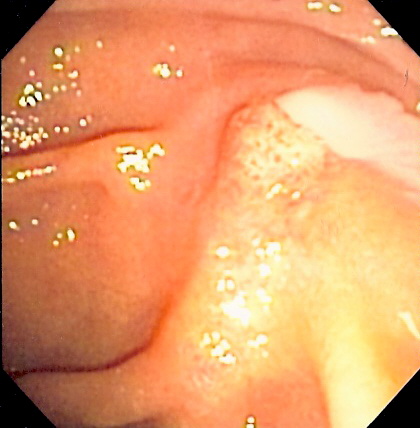Ascending cholangitis
For patient information click here
| Ascending cholangitis | |
 | |
|---|---|
| Duodenoscopy image of pus extruding from Ampulla of Vater, indicative of cholangitis | |
| ICD-10 | K83.9 |
| ICD-9 | 576.1 |
Editor-In-Chief: C. Michael Gibson, M.S., M.D. [1]
Please Take Over This Page and Apply to be Editor-In-Chief for this topic: There can be one or more than one Editor-In-Chief. You may also apply to be an Associate Editor-In-Chief of one of the subtopics below. Please mail us [2] to indicate your interest in serving either as an Editor-In-Chief of the entire topic or as an Associate Editor-In-Chief for a subtopic. Please be sure to attach your CV and or biographical sketch.
Overview
Ascending cholangitis is a cholangitis caused by bacterial infection. Cholangitis, in turn, is an inflammation of the bile duct[1].
Symptoms
The clinical symptoms of ascending cholangitis are pain, jaundice, and fever (Charcot's triad). In addition, the presence of hypotension and mental confusion (Reynold's pentad) is suggestive of severe septicemia. The typical clinical picture is present in only 50% of cases.
Cause
It results from bile stasis due to chronic obstruction, usually by gallstones (choledocholithiasis). This facilitates a bacterial infection.
The infecting organisms are usually gram-negative bacilli (eg, E. coli, Klebsiella, Pseudomonas, and Enterococcus).
Diagnosis
Blood sample
Anaerobes may be cultured in 15% of cases. Laboratory studies show cholestasis, variable transaminase levels, leukocytosis, and positive blood cultures.
Ultrasound
Findings on ultrasound examination are the same as those for choledocholithiasis.
Differential Diagnosis of Causes of Ascending cholangitis
| Gastroenterologic | Gallstones |
| Infectious Disease | E. coli, Klebsiella, Pseudomonas, and Enterococcus |
Treatment
When acute ascending cholangitis is suspected, the patient should be hospitalized. Fluid resuscitation and antibiotics are the key interventions, and antibiotic treatment should be targeted against gram-negative organisms and, possibly, anaerobes. Commonly used drugs include ampicillin, gentamicin sulfate (Garamycin) and metronidazole (Flagyl, Metro IV, Protostat), or ciprofloxacin (Cipro) with or without metronidazole.
The mainstay of therapy, however, is the establishment of biliary drainage, which can be accomplished endoscopically or percutaneously. Timing of the procedure depends on severity of the clinical presentation. Endoscopic retrograde cholangiopancreatography (ERCP) is used primarily. However, if the patient's condition is too unstable for ERCP, percutaneous transhepatic drainage can tide the patient over the acute crisis until definitive therapy can be planned. In all other cases, ERCP to determine the cause of the obstruction and provide drainage should be performed as soon as possible.
Prognosis
Ascending cholangitis can be life-threatening if untreated.